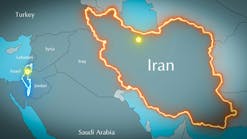Margaret Carson
Enron Corp.Houston
Growing demand for gas as a power-generation fuel is combining with changing patterns of gas transportation to present North American producers and pipelines with a series of new challenges.
Results of a recent Enron study show how natural gas supplies available to U.S. markets continue to shift their center of gravity toward Canadian and western sources.
These changes-demand growth paced by electricity generation and supply source relocation-plus extraordinary gas basin price differentials this winter, point to (a) the opportunities for and risks of adding pipeline capacity in the U.S. and Canada, on the one hand, and (b) tough decisions that may need to be made by Gulf of Mexico and Midcontinent area producers, on the other, to compete in an environment of changing economics and infrastructure.
U.S. supply increases
Gas supplies from U.S. Lower 48 production has increased 3.15 bcfd since 1990, according to U.S. Energy Information Administration Natural Gas Monthly data (Table 1 [43606 bytes]). Increased volumes from New Mexico, the Rockies, and Alabama led these gains.
Oklahoma gas production sustained the largest decline, off 900 MMcfd over the past 5 years. Colorado, Wyoming, New Mexico, and Alabama increased 400, 270, 1,800 and 1,000 MMcfd, respectively.
Fig. 1 [27493 bytes] shows these regional gas supply growth trends.
Canadian export growth
Since 1990, Canadian gas exports to the U.S. have increased 3.505 bcfd, according to Cambridge Energy Research Associates' Natural Gas Watch. This is over and above the 3.15 bcfd of U.S. Lower 48 gas production growth (Table 2 [38123 bytes]).
The largest increases in Canadian gas exports since 1990 occurred via the Iroquois and Niagara export points in the East, up 756 and 460 MMcfd, respectively; in Kingsgate (PGT) in the West, up 743 MMcfd; and in Monchy (Northern Border) in the Midwest, up 588 MMcfd.
U.S. natural gas demand increased by 6.655 bcfd (2.4 tcf/year) in 1995 from 1990. Of this new growth, 53% was supplied from Canadian suppliers and 47% from U.S. producers.
In anticipation of future growth in gas demand, over 70 pipeline expansions in the U.S. and Canada are planned (Table 3 [22900 bytes]).
The planned pipeline activity is greatest in the West, with 20 potential projects, followed by the Midwest with an additional 16 projects. Of course, not all of these projects will be built, and some will be delayed, as a portion of these projects target duplicate markets.
Supply volatility
The large wholesale gas market is moving from domination by the U.S. Gulf Coast to sourcing by multiple supplies to enable shippers to be closer to and more flexible in serving desirable markets. As a result, Enron expects greater seasonal price and supply area volatility.
The regional pricing basis of gas in the mature U.S. markets, combined with the way gas moved in the winter of 1995-96, caused large differences between prices in markets east of the Mississippi and those of western markets, where surplus supplies could not move eastward due to pipeline constraints. Canada supplies about 3 bcfd of gas to the Rockies/Western area alone, which has benefited from low-cost supplies and strong gas supply growth in the face of slower local market growth.
In the East, the Canadian gas supply additions have been the greatest. However, no new pipelines have been added since Iroquois was completed in 1992. But limited growth recently in Gulf Coast gas supplies, coupled with the broad band of cold weather that swept across North America in the face of Canadian and western gas pipeline constraints, caused a strong call on gas supplies for eastern markets last winter.
More mega-traders and producers are obtaining released gas pipeline capacity and shipping more of U.S. gas supplies in lieu of the traditional gas distributors, often using unconventional market tools and services.
The increased volatility of prices for gas at major hubs and city gates during the recent cold spell in January 1996 are shown in Fig. 2 [23953 bytes]. The price differentials from Chicago to New York City reached $2.28/MMBTU and $1.68/
MMBTU from Monchy, at the Canadian border, to the Chicago hub. A $2.00/MMBTU spread existed between Opal, Wyo., gas and Chicago this past January.
These compare with price differentials of 78°/MMBTU from Chicago to New York City and 60°/MMBTU from Monchy to Chicago, in a more normalized January 1995 winter month, while a modest 37°/MMBTU spread existed between Wyoming and Chicago in January 1995 (Fig. 3 [33212 bytes]).
However, widening differentials in the winter months typically do erode as markets move into spring and summer. The tough decisions that need to be made by pipelines and producers can often be supported based on market economics in the winter season that are absent during the rest of the year.
Enron's outlook for the year 2000 shows an increase of 4.84 bcfd in gas use, with power generation leading the gains. More gas used in existing facilities leads this trend (Table 4 [34445 bytes]).
The future
In response to these trends, producers will either (a) opt to develop gas plays that provide pipelines and producers multiple market access routes, unlike the more unilateral market supply strategies of the past, or (b) diversify their production area development activities to provide increased market servicing flexibility.
Pipelines, likewise, will need to make some tough capital expenditure and regional strategy decisions in an environment where:
- Capacity release by distributors may change the makeup of shippers to more mega-marketers.
- Electricity generation demand for gas in the face of increased wholesale electricity competition will place greater wholesale demands on gas pipeline dispatch flexibility.
- Like producers, given the greater sophistication of the markets that will need to be served by 2000, pipelines will aim to tie into the lowest cost production basins on the supply end, while extending their access through new construction, joint ventures, and interconnects on the market side to reach as many desirable markets as possible throughout the year.
The Author
Margaret M. Carson is director of corporate strategy and competitive analysis for Enron Corp., Houston. She joined Enron in 1987.
A graduate of the University of Pittsburgh, she also holds an MS in management from Houston Baptist University.
Copyright 1996 Oil & Gas Journal. All Rights Reserved.


